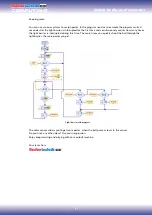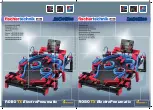
ROBO TX ElectroPneumatic
COMPUTING
6
Switching compressed air – solenoid valves
In pneumatics the purpose of a valve is to control the flow of air to the pneumatic cylin-
der so that the cylinder either extends or retracts. The valve can be actuated either by
hand, pneumatically or electromagnetically as on your technical models.
Technical data on valve: 3/2-way valve, 9V DC/130 mA
3/2-way means that the valve has three connections and two switching states.
Note:
When connecting the valve to the power source or to the ROBO TX Controller ensure
that the polarity is correct.
Brief technical explanation:
Applying a voltage to the coil (1) creates a magnetic field which pulls down core (2).
The valve opens and the air flows from connection "P" through connection "A" to the
cylinder. When voltage is not applied, the core is pressed upward by the spring (3) and
the valve is closed.
When the valve is closed, connection "A" is connected to the vent "R". This is important,
to allow the air to escape from the cylinder.
The connections are always designated as follows in pneumatics:
P = Compressed air connection
A = Connection to cylinder
R = Vent
Interaction of electrical and pneumatic circuits
Task:
Actuate a solenoid valve to extend a
single acting cylinder
. The cylinder should
extend when the operator closes a switch. As long as the switch is closed, the
cylinder should remain extended. When the switch is returned to the initial posi-
tion, the pressure of the spring should cause the cylinder to retract.
Engineers frequently use symbols to show such tasks. One circuit diagram shows the
electrical part and one the pneumatic part or stage.
3/2-way valve
P
A
R
(1)
(2)
(3)
P
R
A
Circuit diagram of a 3/2-way valve
Содержание COMPUTING ROBO TX ElectroPneumatic
Страница 1: ......
Страница 18: ...ElectroPneumatic ElectroPneumatic ...




































